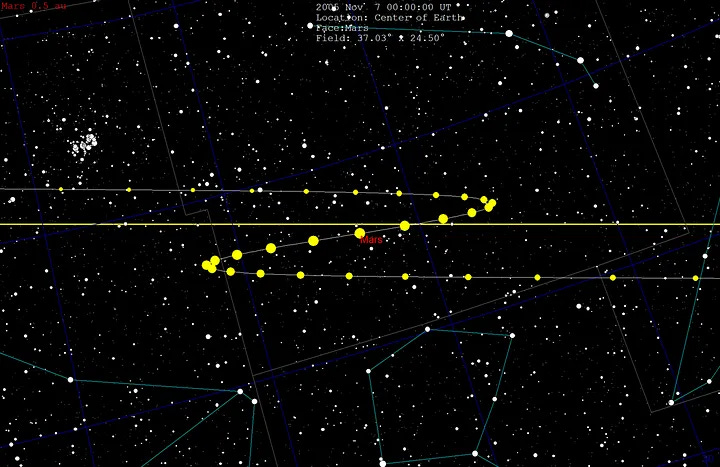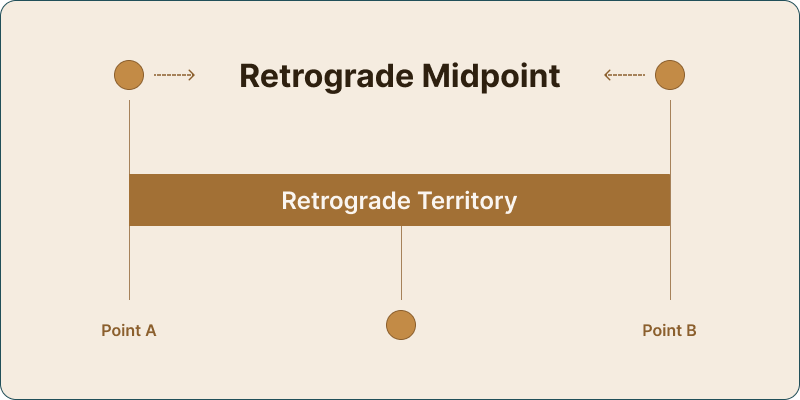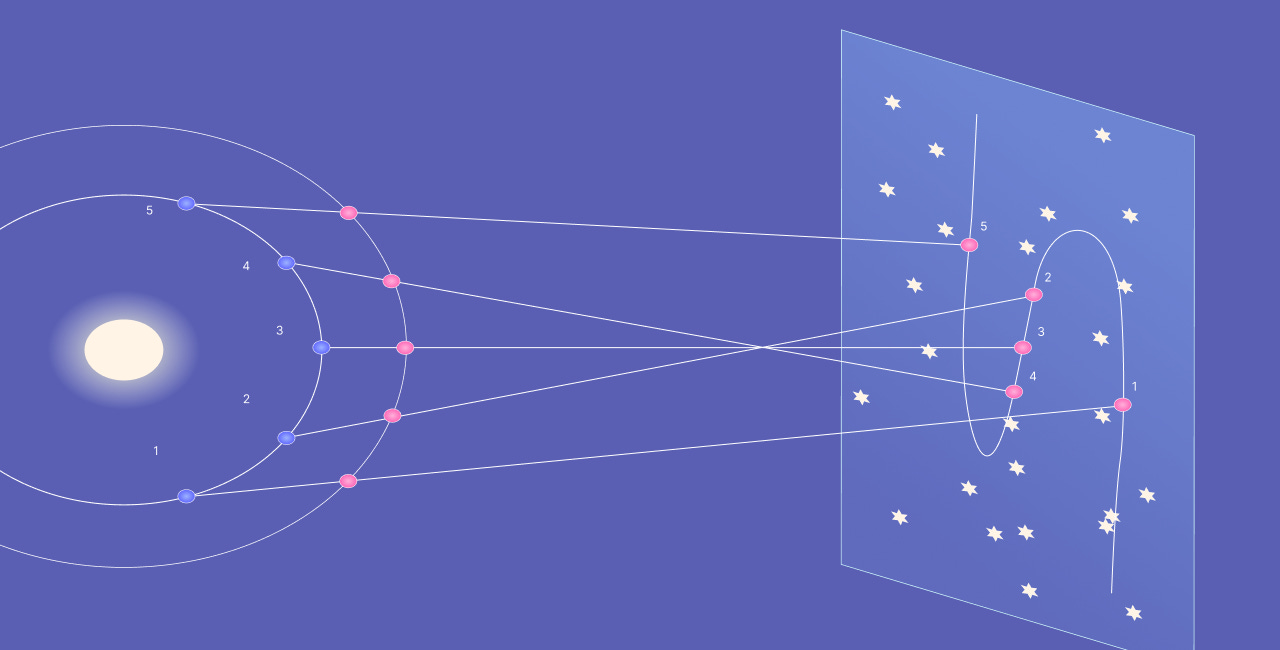Hi Everyone,
This article is part 1 of a 3-part series on retrogradation. Originally posted on Astrology Journal, this version has been substantially revised to provide a clearer introduction to the topic.
Retrogradation, or backward movement, is a significant part of planet cycles, including but not limited to Mercury’s cycle (and excepting the cycles of the Sun and Moon).1 Understanding this phenomenon and how to interpret it helps us become better astrologers because it enhances our ability to discern the meaning encoded in charts.
In this short article series, we’ll look at what the retrograde cycle is, how it is constructed, and how we can use this structure to tell the story of the retrograde cycle. To help us tell it, we’ll draw on the developmental concept of a hesitation and the astrological Sabian symbols.
The Sabian symbols are word pictures that serve as meaningful ciphers for each zodiac degree. They can help us tell the story of a specific transit, including a retrograde transit. A hesitation is a developmental pause preceding a shift to a new developmental stage. The benefit of using the filter of a developmental hesitation is that it allows us to tell a life- and human-affirming story about a specific part of our journey here on Earth, linking it to a larger cosmic cycle.
For this article, we’ll limit our focus to what retrogradation is, its structure, and its basic symbolic meaning. In part 2, we’ll look more deeply at the structure, dive into the Sabian symbols and hesitation, and learn how to construct a meaningfully compelling story for a given retrograde cycle.
In part 3, we'll apply these tools to analyze a specific retrograde cycle, bringing together all the elements we've explored.
The Retrograde Cycle: Foundations in Astronomy
As planets move through the sky, they appear to move through a backdrop of constellations that, from our perspective on Earth, appear to line their orbital path. This set of constellations is known as the zodiac. We know these constellations as Aries, Taurus, Gemini, Cancer, Leo, Virgo, Libra, Scorpio, Sagittarius, Capricorn, Aquarius, and Pisces.
Notice that the names of the constellations are the same as the names of the astrology signs. In reality, the constellations and signs are different things, but, for this series, we can think of them as equivalent.
As a general rule, planets move forward through the zodiac - from Aries to Taurus to Gemini, etc. However, each planet, except the Sun and Moon, also moves backward during parts of its transit, i.e., in reverse order of the zodiac. This backward motion is known as retrogradation.
When planets move forward through the zodiac, we say they are moving direct or in direct motion. When planets move backward through the zodiac, we say they are moving retrograde. Mercury retrograde is an example that you have probably heard about. When astrologers say that Mercury is retrograde, they mean that it appears to be moving backward through the zodiac.
Retrogradation is recognized as a phenomenon by both astronomers and astrologers, but it does not actually happen. It only appears to happen from our perspective on Earth. When viewed from the perspective of the Sun, we would not see any planet move backward at any point in its orbit. These two different perspectives are called geocentric, meaning Earth-centered, and heliocentric, meaning sun-centered, respectively.
Even though retrogradation is an optical illusion, because it is what we see from our geocentric perspective, astrologers consider it symbolically meaningful. Exploring its symbolic meaning is the purpose of this series.
The optical illusion happens in part because the Earth moves faster or slower than the other planets. If we have ever been in a train that passes another train going in the same direction or in a car that passes another car going in the same direction, we have some experience with this kind of optical illusion. As we pass the slower-moving train or car, it appears to move backward. Although it’s not actually doing so, it’s what we see and it can have a disorienting effect on us.2
In the sky, when the Earth catches up to and moves past a slower-moving planet, the slower-moving planet appears to move backward. But, because the Earth moves in a circular orbit and spins on its axis on a tilt as it passes the other planet, we see something more elaborate than what we see when we pass a slower-moving train or car. Although I find it difficult to visualize, rather than seeing the slower-moving planet move backward in a straight line like the train or car appears to do, we see it make either a loop or an s-curve in the sky, as shown in the following images:3


For practical purposes, while every astronomical detail can potentially provide symbolic insight from an astrological perspective, the detail about which shape a planet appears to trace in the sky is not essential for grasping the core concept of retrogradation. That concept is:
planets sometimes appear to move backward in the sky and this backward motion is symbolically meaningful
In the graphics used in the next section, I use simple, linear illustrations to explain the concept.
Astrological Structure
Astrologically, a retrograde planet signifies an inward-drawing time for revisiting and reviewing something from our past, recent or otherwise, that may need rethinking or reworking. Because of this inward-drawing quality, we can think of retrogrades as carrying yin energy. In part 2, we’ll look at the developmental hesitation as an analog to this cosmic inward-drawing period. For now, we’ll move on to the composition of a retrograde cycle.
Retrograde Phases
There are three primary phases to any planet’s retrograde journey: a lead-up phase, a retrograde phase, and a completion phase. We can also call these phases periods. Together, they form the retrograde cycle.
In the lead-up phase, the planet has not yet turned retrograde but is nearing the moment when it will. In the retrograde phase, the planet moves retrograde. In the completion phase, the planet, having finished up its retrograde motion, moves direct again.
Astronomically, before and after a planet turns retrograde, it appears to slow down. This slower motion makes sense as, before and after a retrograde period, a planet appears to stop in the sky before changing direction. After stopping, it then appears to start moving in the new direction, first slowly and then increasing in speed. Astrologers call these moments when a planet appears to stop moving stations. We won’t be considering stations in this series but it is good to know about them.
To determine when the lead-up phase to retrogradations begins and the completion phase ends, astrologers note the beginning and end points of a given planet’s retrograde period. As shown in Graphic 1, these points demarcate a stretch of the zodiac that we can call the retrograde territory. As we will see in Graphic 3, all three phases occur within this retrograde territory.

We also identify a midpoint to the cycle. While it would make sense to do so by determining the halfway point of the retrograde territory, the precise midpoint is determined by the planet’s movement rather than by the territory it demarcates. Specifically, the midpoint is determined by when the planet either opposes or conjuncts the Sun during the retrograde part of the cycle. While this alignment often occurs near the geographic center of the retrograde territory, the actual alignment determines the midpoint.
Graphic 2 shows an idealized midpoint at the exact center of the territory. In part 2, we’ll use the midpoint to help us construct the narrative arc of the retrograde cycle. For now, understanding what the midpoint is and how to determine it is sufficient.

As shown in Graphic 3 below, the lead-up phase starts when the planet first enters the retrograde territory and continues until the planet turns retrograde (top long arrow). The retrograde phase starts when the planet first turns retrograde and continues until it turns direct (middle long arrow). The completion phase begins when the planet first turns direct and ends when it reaches the end of the retrograde territory (bottom long arrow).

Thus, during the retrograde cycle, the planet passes over the same stretch of zodiac three times. Astrologically, we give each part of the cycle a name and note that each carries its own symbolic meaning. We call the lead-up and completion phases shadow periods because we see traces of what we find in the retrograde period, both before it starts and after it finishes. We call the retrograde period just that.

Each phase of the retrograde cycle carries a distinct symbolic meaning. In the next section, we'll sketch out those meanings. In part 2, we'll develop this symbolism further to help us tell the story of the retrograde cycle.
Astrological Symbolism
First Shadow Period
The first part of the cycle is the period leading up to the retrograde period. During this time, the planet moves in direct (or forward) motion over the degrees it will transit back over once it turns retrograde.
Symbolically, this first part of the cycle is a time when we have our first encounters with inner and/or outer experiences that may foreshadow what we will be revisiting during the next legs of the retrograde cycle. We can think of these experiences as like ripples in the ocean suggesting a larger wave to come, though we may not recognize their significance at this time. Alternatively, we can think of a scout venturing ahead to get intel on what is to come.
Drawing on the scout metaphor, to distinguish between the two shadow periods, I often call this first one a reconnaissance period, as shown in Graphic 5 below. During this part of the cycle, we are not fully conscious of the intel being gathered, still carried forward by the normal flow of our lives. But we are having experiences that are being registered that we may revisit during the retrograde period.

Retrograde Period
The second part of the cycle is the retrograde period. During this period, the planet moves retrograde, or backward through the signs, initiating a time of review. The normal forward flow that has been carrying us through life has temporarily halted. As we journey through this territory, something may arise that will prompt us to turn inward and review some aspect of our lives or some decision we have made.
Drawing on the scout metaphor, we can say that the scout has turned around, but has not yet made it back to us. Without the intel, we encounter obstacles that we were not anticipating. These encounters invite or require us to stop and reconsider our course.
During retrograde periods, our best tack is to hold off on making major decisions relative to the planet involved, but this may not always be possible. If we must decide something, we do so knowing that we may need to revise it at some point.
Second Shadow Period
In the second shadow period, the planet begins moving direct again, passing over the degrees of the retrograde territory one last time. The flow has returned but has been adjusted closer to true according to our retrograde experience.
Returning to the scout metaphor, we can say that the scout has returned with clarifying information, stimulating awareness and insight. What was unconscious during the reconnaissance period and unclear during the retrograde period now comes into focus. With this clarity, we are able to integrate our experiences. For this reason, to distinguish it from the first shadow period, I often call it an integration period, as shown in Graphic 6 below.

Preview: Part 2
That gets us up to speed with the basics of the retrograde cycle. In part 2, we'll delve into how to construct a retrograde narrative that aligns with our human experience of the developmental growth process. Linking these two cycles together will make our interpretations more meaningful, compelling, and practically insightful regarding our life experiences. In the process, we will open up our curiosity to the possibility that our human growth process is but a fractal of a larger, encompassing, and ever-assisting cosmic growth pattern.
Cover Image Credit

Updates
January 29, 2025
I added a link to part 2.
I moved the Cover Image Credit above the References and link to part 2.
References/Resources
Planet Retrogradation: Videos
LiveScience. (2018, Jan 13). Backwards-Moving Mars: What Does 'Retrograde' Mean? [Video]. Youtube.
Vedic Astrology Through Animations. (2020, Apr 21). What is Planetary Retrograde. A Complete Description. (In under 3 minutes). Youtube.
Planet Definition: Etymology and History
What is a Planet? It’s a simple question with a complicated answer. (n.d.) NASA Science.
Notes
In astrology, the Sun and Moon are considered planets. Their designation as such traces its roots back to Hellenistic times, where we find the source of our word planet: the Greek equivalent, planēt, means wanderer. Like the other visible planets, the Sun and Moon wander through the sky. In this regard, they were and are no different than the other planets. For an article talking about the roots of the word planet and the history of planet discovery and designation, see NASA Science’s article, What is a Planet? It’s a simple question with a complicated answer.
For a helpful video on retrogradation that uses a car analogy to explain the optical illusion that occurs when one speeding object passes another moving in the same direction, see the LiveScience video. This video also goes into the more nuanced details of retrogradation in a helpful way.
For helpful video explanations and animations illustrating the finer points of planet retrogradation, see the LiveScience and Vedic Astrology Through Animations videos.




